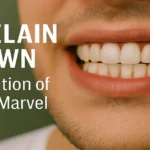For most of human history, losing a tooth was a permanent sentence: a gap to be hidden, an imperfection to endure.
Today, however, restorative dentistry has evolved into an intricate art and precise science, offering not only functional repair but aesthetic rejuvenation – Porcelain Crown.
At the forefront of this transformation is the porcelain crown — a dental innovation that symbolizes the convergence of medicine, technology, and design.
This is the story of the porcelain crown: its origins, its artistry, its cultural significance, and its future at the intersection of biotechnology and personalized healthcare.
What Is a Porcelain Crown?
Simply put, a porcelain crown is a type of dental restoration that fully encases a damaged, decayed, or misshapen tooth.
- Function:
Restore strength, shape, size, and appearance. - Material:
Crafted entirely from dental-grade porcelain or ceramic — substances prized for their natural look and biocompatibility. - Placement:
Cemented permanently over the prepared tooth, acting as a protective helmet.
Unlike simple fillings or onlays, a crown envelops the entire visible portion of a tooth, providing maximum reinforcement.
But modern porcelain crowns are more than shields — they are sculptures, each custom-designed to blend invisibly within the dynamic landscape of a patient’s smile.
A Brief History of Crowns: From Gold to Porcelain
Crowns have a surprisingly ancient history.
1. Antiquity:
- The Etruscans (circa 700 BC) created rudimentary dental appliances from gold.
- Archaeological remains reveal early forms of tooth capping with precious metals, shells, and even ivory.
2. The Middle Ages to Renaissance:
- Dental technology stagnated in Europe, with little innovation beyond rudimentary extractions and crude prosthetics.
3. 19th Century:
- Innovations like porcelain “fused to metal” crowns emerged.
- Early ceramic technologies, while aesthetically appealing, lacked durability.
4. 20th Century:
- Porcelain-fused-to-metal (PFM) crowns became the gold standard: a strong metal core layered with porcelain.
- Full ceramic crowns were introduced later, initially for cosmetic zones like front teeth.
5. 21st Century:
- Advances in material science have created high-strength ceramics (like zirconia-reinforced porcelain), allowing full porcelain crowns even on molars.
The trajectory is clear: from crude survival mechanisms to aesthetically nuanced restorations virtually indistinguishable from natural enamel.
Why Choose a Porcelain Crown? Key Indications
Dentists recommend porcelain crowns in a range of clinical and cosmetic situations.
1. Severe Tooth Decay or Structural Damage
When a tooth is too damaged for a filling or onlay, a crown provides the needed strength to prevent fracture.
2. Root Canal Therapy
Following a root canal — which hollows the tooth’s internal structure — a crown seals and protects the weakened shell.
3. Aesthetic Enhancement
Porcelain crowns can correct:
- Discoloration unresponsive to whitening.
- Misshapen or undersized teeth.
- Gaps and minor misalignments.
4. Restoration After Trauma
Accidents resulting in cracked or broken teeth often require crowning for both function and appearance.
5. Support for Dental Bridges
Crowns can anchor a bridge, filling gaps left by missing teeth.
The Porcelain Crown Procedure: Step-by-Step
Understanding the process demystifies the experience:
Initial Consultation
- Digital X-rays and photographs assess structural integrity.
- Dentist discusses goals — functional, aesthetic, or both.
Tooth Preparation
- The tooth is reshaped, removing 1-2 millimeters of enamel to accommodate the crown’s thickness.
- Local anesthesia ensures comfort.
Impression Taking
- Traditional molds (putty-like materials) or digital intraoral scans capture exact tooth and bite dimensions.
Temporary Crown
- A temporary acrylic or resin crown protects the prepared tooth while the porcelain version is crafted.
Crown Fabrication
- A dental lab or in-office milling system (e.g., CEREC) sculpts the crown using precision software and artisan techniques.
- Color matching ensures seamless integration.
Final Placement
- After verifying fit and aesthetics, the permanent crown is cemented using high-strength adhesives.
The entire process typically spans two appointments, though same-day crowns are increasingly common.
Types of Porcelain Crowns: A Nuanced Choice
Porcelain is not monolithic. Choices abound depending on clinical needs and aesthetic priorities:
| Type | Characteristics | Best For |
|---|---|---|
| Feldspathic Porcelain | Traditional, highly esthetic | Front teeth |
| Lithium Disilicate (e.g., E.max) | Strong, translucent | Front and back teeth |
| Zirconia-Reinforced Ceramic | Ultra-strong, slightly opaque | Molars, grinders |
| Pressed Ceramic | Dense, durable | Mixed-use |
The artistry lies in selecting — and shaping — the right material for each unique smile.
Advantages of Porcelain Crowns
- Natural Appearance:
Porcelain mimics enamel’s translucency, texture, and gloss. - Biocompatibility:
Low allergic reactivity compared to metals. - Durability:
When properly maintained, porcelain crowns last 10–20 years. - Stain Resistance:
High-quality porcelain resists food and drink discoloration. - Customization:
Color, contour, and fit tailored to individual needs.
Limitations and Risks
No procedure is without potential drawbacks.
- Cost:
Porcelain crowns are expensive, often ranging from $1,000 to $3,500 per tooth. - Fragility:
While strong, pure porcelain can chip under extreme force (e.g., teeth grinding). - Sensitivity:
Post-procedure sensitivity to hot/cold may occur temporarily. - Wear on Opposing Teeth:
Highly polished crowns minimize this, but unpolished surfaces can cause attrition.
Awareness of these risks enables patients to engage in informed, realistic decision-making.
Maintaining a Porcelain Crown: Best Practices
A porcelain crown requires the same — if not greater — care as natural teeth:
- Meticulous Oral Hygiene:
Floss daily; crowns can still develop decay at margins. - Avoid Hard Foods:
Ice, hard candies, and popcorn kernels are risks. - Night Guards:
Patients with bruxism (teeth grinding) should wear custom protectors. - Regular Check-Ups:
Dentists monitor crown integrity, bite harmony, and underlying health.
Proper maintenance transforms a porcelain crown from a short-term fix into a long-term asset.
The Cultural Significance of Dental Crowns
Beyond health, crowns have deep cultural resonance:
- Symbols of Wealth and Status:
Historically, gold crowns signaled affluence. - Hollywood’s Smile Standard:
Porcelain crowns underpin many of the “perfect” celebrity smiles. - Global Variations:
In Japan, dental crowns were historically considered a rite of adulthood.
Thus, restoring a tooth often restores more than function — it restores social belonging, self-confidence, and personal dignity.
Porcelain Crowns vs. Alternatives
How does porcelain stack up against other restorations?
| Option | Pros | Cons |
|---|---|---|
| Gold Crowns | Extremely durable | Noticeable appearance |
| PFM Crowns | Strong, esthetic | Risk of metal showing at gum line |
| Resin Crowns | Cheap, fast | Fragile, stains easily |
| All-Porcelain | Natural appearance, safe | Higher cost |
Porcelain crowns offer a compelling balance for patients valuing beauty, safety, and function equally.
Innovations Shaping the Future of Porcelain Crowns
Technology continues to refine crown artistry:
- AI-Driven Design:
Machine learning predicts optimal crown contours based on millions of datasets. - Bioactive Ceramics:
New materials may actively promote gum and bone health. - 3D Printing:
Advanced 3D printers may soon fabricate crowns chairside in under an hour with unprecedented precision. - Smart Crowns:
Prototypes exist for embedded sensors monitoring bite force, temperature, and pH — potentially alerting wearers to emerging issues.
In short, tomorrow’s crowns may not just restore — they may enhance.
Psychological Dimensions: Smiles and Identity
Smiles are intrinsic to human connection.
A broken or missing tooth can cause profound shame, social withdrawal, and professional disadvantage.
Porcelain crowns offer more than mechanical repairs:
- They restore self-expression.
- They enable spontaneous joy.
- They support psychological resilience.
Restoring a single tooth can ripple outward, transforming relationships, careers, and self-perception.
In this way, dentistry intersects with psychology, sociology, and even politics (as access disparities persist).
Conclusion: Porcelain Crowns at the Crossroads of Art, Science, and Humanity
The story of porcelain crowns is the story of human aspiration:
- To repair what is broken.
- To perfect what is flawed.
- To reclaim what is lost.
Today’s crowns are marvels of technology and art — handcrafted micro-architectures that restore more than dental function.
They rebuild confidence, dignity, and connection.
In an era increasingly focused on artificial intelligence and digital avatars, porcelain crowns remain profoundly, refreshingly human:
Real solutions, for real smiles, in a real world.
And that, perhaps, is their most enduring beauty of all.







